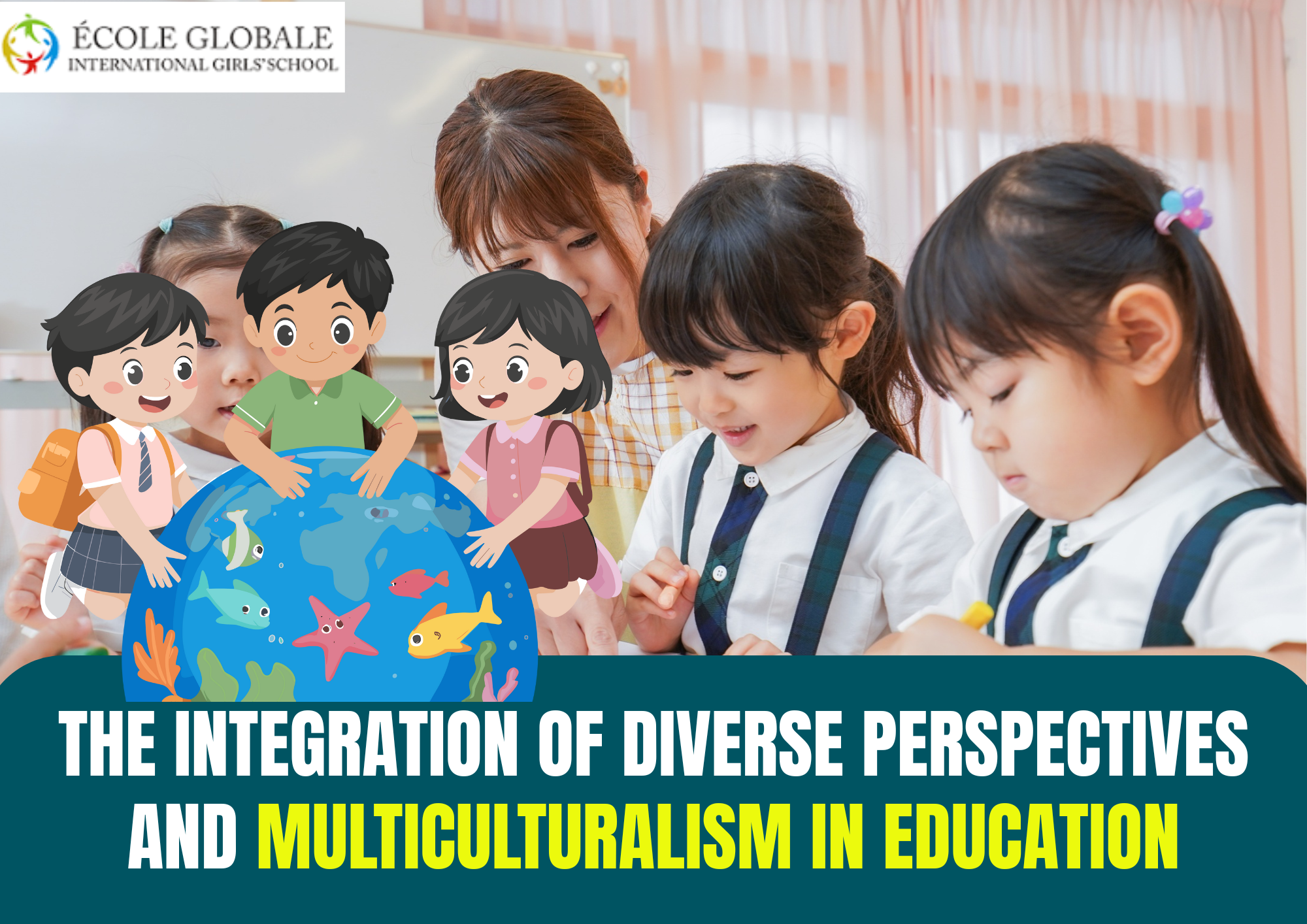Given the changing demographics of American society and the increasing diversity in classrooms, it is imperative that educators be attuned to their own cultural biases and make informed decisions about selecting curricula. As per research conducted by the Best International Schools in India, has demonstrated that when teachers select materials based on their own personal beliefs and values, they are more likely to teach from a limited perspective.
Historical context of diverse perspectives and multiculturalism in education

Early education and Eurocentric perspectives
Early education was based on the belief that there was a single, universal human nature and that all people were endowed with similar cognitive abilities and potentials. The first educational institutions were created for the purpose of ensuring the reproduction of society through the transmission of cultural values
Move toward diverse perspectives and multiculturalism in education
According to the top Schools in India, move from a singular focus on literacy skills toward an emphasis on multiple literacies began in the 1970s when cultural minorities began challenging the status quo by demanding access to education in their native languages. This movement toward multiculturalism occurred within schools across North America where it was believed that each culture should be taught within its own context so that students could learn about themselves within their own communities.
Contemporary approaches to multicultural and diverse education
The new approaches to multicultural education that emerged in the late 1980s and early 1990s were linked to a broader concern with diversity, difference, and social justice. They also reflected a new recognition of the need for educators to consider the political implications of their work and its impact on society at large. These approaches sought to go beyond earlier multicultural models by addressing issues such as power and privilege, racism, sexism, homophobia, classism, and ableism.
The goal is not so much understanding other cultures as it is ensuring equal access for all students regardless of ethnicity or race.
Challenges and How to Overcome Them
While integrating multicultural education has benefits, schools may face challenges:
| Challenge | Solution |
|---|---|
| Resistance from traditional curricula | Gradually introduce multicultural content alongside standard topics |
| Limited teacher expertise | Conduct training workshops on inclusive pedagogy |
| Cultural misunderstandings | Facilitate open discussions and reflection sessions |
With thoughtful planning, these obstacles can be addressed effectively, creating an inclusive and engaging learning environment.
Benefits of incorporating diverse perspectives and multiculturalism in education

Diverse perspectives and multiculturalism in education
There is a growing body of research that suggests that teaching about diverse perspectives and multiculturalism can improve critical thinking skills, enhance cultural competence, increase understanding and empathy for others, and prepare students for a globalized world. This page provides a brief overview of some of this research.
Improved critical thinking skills
A number of studies have found that teaching about diverse perspectives improves critical thinking skills. For example, the International Center for Leadership in Education (ICLE) conducted an extensive review of research on teaching about diversity and concluded that “the evidence suggests that diversity education can improve students’.
Critical thinking skills through increased awareness of social issues, greater comfort with ambiguity and complexity, improved perspective-taking abilities, enhanced ability to generate new ideas by combining ideas from different sources, improved understanding of group dynamics across cultures or ethnicities (e.g., stereotypes), greater sensitivity to one’s own culture or ethnic group as well as others’ cultures or ethnic groups (i.e., self-awareness), increased empathy toward other groups (which may help reduce prejudice), increased motivation to serve people from other cultures or ethnicities (which may lead to more active citizenship), and improved ability to work.
Enhanced cultural competence
Cultural competence is defined as the ability to function effectively in intercultural situations. Students who are culturally competent can interact comfortably with people from diverse cultures, adapt to new cultural environments and understand the nuances of communication that occur across cultures
Students who are culturally competent have a greater appreciation for other people’s beliefs, values and customs. By incorporating diverse perspectives into the curriculum, teachers can help students develop an understanding of their own culture as well as those of others. This will enable them to interact easily with people from different backgrounds and learn how to work cooperatively with them on projects or assignments.
Greater understanding and empathy for others
The benefits of diverse perspectives and multiculturalism in education are not just limited to students who are from diverse backgrounds. The benefits also extend to students who do not have a personal connection with someone from another culture. Students who have never experienced another culture or been exposed to diversity in their lives can still learn from the experience of other cultures and become more open-minded as a result.
Preparation for a globalized world
The world is becoming increasingly interconnected, so it is important that we prepare our children for this reality and teach them how to interact with people from different backgrounds, races, religions and cultures. This isn’t just about respecting other people’s differences; it’s about learning how to get along with them and adapt when necessary.
Challenges in integrating diverse perspectives and multiculturalism in Education

The challenges of integrating diverse perspectives and multiculturalism in Education into the curriculum are rooted in resistance to change, limited resources, inadequate teacher training, and challenges in creating inclusive curricula.
Resistance to Change:
The challenge of integrating diverse perspectives and multiculturalism in Education into the curriculum is rooted in resistance to change on the part of teachers and administrators. In some cases, teachers may not be willing or able to incorporate new material into their existing curricula or may have difficulty with teaching a new topic. In other cases, teachers may simply be uncomfortable teaching outside their comfort zone or feel they lack sufficient preparation.
Limited Resources:
Limited resources can also pose a challenge for teachers who are trying to integrate diverse perspectives into their curricula. When faced with limited time and resources, teachers must choose what topics they will cover with their students and which they will leave out; this means that some topics may not be covered or covered at all simply because there is not enough time to teach them all.
Inadequate Teacher Training:
Inadequate teacher training can also impede progress toward integrating diverse perspectives into the curriculum because, without adequate training, many teachers do not know how best to approach such a task or how to go about doing so effectively.
Strategies for promoting diverse perspectives and multiculturalism in education

Professional development for teachers
- Teaching requires a combination of knowledge and skills that can be learned through formal and informal learning experiences, including education courses, mentoring, and on-the-job training. Teachers may benefit from ongoing professional development to enhance their knowledge about cultural differences and multiculturalism in education.
- Professional development should include opportunities for teachers to learn about the impact of their own background and culture on how they approach teaching and learning, as well as strategies for promoting diverse perspectives in their classrooms. In addition to providing theoretical frameworks for understanding diversity, this training should also help teachers develop practical skills for working with students from different backgrounds.
- Teachers can also benefit from learning about resources available within their own schools or districts (e.g., curriculum materials that incorporate diverse perspectives) or in their communities (e.g., local museums). Resources such as these can help teachers integrate these materials into their daily lessons while also encouraging students to explore new topics in greater depth than they might have otherwise chosen on their own.
- Professional development programs should include opportunities for teachers to reflect on the effectiveness of their practices so they can better understand why certain strategies work well with some groups.
Conclusion
The integration of diverse perspectives and multiculturalism in education is no longer optional — it is essential for preparing students to thrive in an interconnected world. By valuing and including multiple viewpoints, educational institutions nurture critical thinkers, responsible citizens, and globally aware individuals.
FREQUENTLY ASKED QUESTIONS
Q1. What are diverse perspectives in education?
Ans: Diverse perspectives include different cultural, social, and experiential viewpoints that students and teachers bring into the classroom, enriching learning and discussion.
Q2. Why is multiculturalism important in schools?
Ans: Multiculturalism ensures that students from all backgrounds feel represented and teaches respect, empathy, and collaboration across cultures.
Q3. How can teachers integrate multiculturalism effectively?
Ans: Through inclusive curriculum design, collaborative projects, cultural celebrations, and teacher training in inclusive pedagogy.
Q4. Does multicultural education improve academic performance?
Ans: Yes, it fosters critical thinking, creativity, and engagement, which can positively impact overall academic outcomes.
Q5. Can multiculturalism reduce bias among students?
Ans: Absolutely. Exposure to diverse cultures and perspectives encourages tolerance, understanding, and reduces stereotypes.
For any queries related to parenting, schooling, or any student-related tips, click here to check out our latest blogs.






